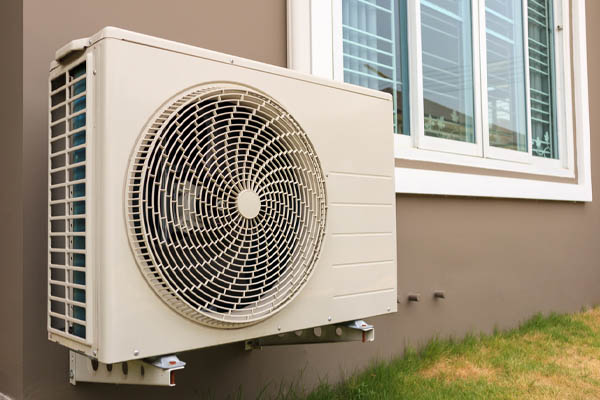Contents
Ductless air conditioning systems differ significantly from traditional central air conditioners. These systems, true to their name, operate without the complex network of ducts. Like their central counterparts, they effectively remove warmth and moisture from indoor air and expel it outside, but they do this directly within the specific area they serve. Unlike central systems, which rely on a network of ducts to disperse cool air throughout a building, ductless units provide immediate cooling to designated rooms or spaces. Yet, a common query among many homeowners remains, “How do ductless air conditioners work?”
Understanding the Functionality of Ductless Air Conditioners
Here are more information regarding this topic:
Parts of a Ductless Air Conditioner

At the heart of ductless air conditioning technology are three primary components:
- Indoor Evaporator/Blower Unit: This component is the indoor face of the ductless air conditioner, residing within the space it cools. Characteristically sleek and around three feet in length, this unit has a critical role. It draws in the room’s warm air, extracts the heat and moisture, and then circulates cooled air back into the space. Simultaneously, it expels the absorbed heat and moisture externally through a conduit system.
- Conduit: As the crucial link between the indoor and outdoor components of the ductless air conditioner, the conduit is a slender, elongated bundle housing essential elements. It contains the refrigerant tubing, a condensation drain, and a power cable. The conduit supplies electrical power to the indoor and outdoor units and acts as a pathway for expelling the heat and moisture from the indoors to the outside unit.
- Condenser: Located outside the building, the condenser’s main job is to receive all the heat transferred from the indoors and effectively release it into the outdoor environment.
Single-Zone Mini-Split & Multi-Zone Ductless Configurations
The versatility of ductless air conditioners is evident in their effectiveness in individual rooms and multi-room applications. These systems can be fitted to suit different needs, encompassing two main configurations:
Single-Zone Mini-Split Systems
Each mini-split system consists of a single indoor evaporator/blower unit and an outdoor condenser, making it perfect for cooling individual rooms. If there’s adequate outdoor space, installing multiple such systems, each with its own condenser, is possible. This setup allows for simultaneous cooling of different areas in a building, with each zone having independent temperature control. Additionally, if one unit experiences issues, it won’t impact the functioning of others.
Multi-Zone Ductless HVAC Systems
These systems come in two variations. The first type uses one outdoor condenser connected to several indoor evaporator/blower units. Each indoor unit has a thermostat, enabling simultaneous activation for cooling as needed. This setup is cost-effective and particularly suitable for buildings where different rooms have varying cooling requirements.
The multi-zone mini-split system offers an exceptional solution for those seeking a truly personalized approach to climate control. This advanced configuration features separate compressor circuits for each evaporator/blower unit. This design lets occupants in different zones independently adjust and control the temperature settings according to their specific preferences and needs.
Do Ductless Air Conditioners Have Adequate Cooling Power?
Despite their compact appearance, ductless air conditioners are proficient in cooling single zones or rooms. To ensure optimal performance, it’s crucial to align the unit’s BTU (British Thermal Unit) capacity with the size of the area it intended to cool. Generally, larger spaces require units with higher BTU ratings. Consulting with an HVAC contractor is advisable to determine the appropriate cooling load for your specific needs accurately. They will consider various factors to recommend the most suitable unit for your space.
A system that’s too small will struggle to cool the area adequately, leading to excessive strain and faster wear and tear on the ductless unit. On the other hand, installing a system that’s too large for the space can cause it to short cycle. This means the system will repeatedly turn on and off. Listed below are the common sizes available:
- For rooms between 400 and 650 square feet, opt for a unit offering 12,000 BTUs per hour.
- If your room measures between 600 and 1000 square feet, a unit providing 18,000 BTUs per hour is recommended.
- For larger spaces, particularly those ranging from 800 to 13000 square feet, a unit with a capacity of 24,000 BTUs per hour is needed.
To ensure you select the most suitable ductless air conditioning system for your space, it’s advisable to consult with a licensed HVAC contractor.
Advantages and Disadvantages of Ductless Air Conditioners
In this discussion, we’ll delve into the benefits and drawbacks of ductless cooling systems:
Advantages of Ductless Air Conditioning Systems
- HVAC Zoning: Ductless air conditioners offer built-in zoning capabilities, allowing occupants in each room to tailor temperature settings to their preferences.
- Efficiency: Ductless air conditioners excel in energy efficiency. Traditional duct systems can result in 20 to 30 percent of conditioned air wastage due to duct leaks, as reported by Energy.gov. Ductless cooling systems eliminate this concern, saving energy and costs.
- Easy Installation: Ductless air conditioning units are a cost-effective cooling solution, particularly for homes lacking pre-installed ductwork. Many older residences lack the necessary space for ductwork installation. Additionally, setting up ductwork typically entails intrusive and expensive processes such as cutting through walls, floors, and ceilings.
- Versatile: Ductless A/Cs offer versatility, as they can be installed on the floor, walls, or ceilings, adapting to your home’s specific configuration.
Drawbacks of Ductless Cooling Systems
While ductless AC systems may have a higher initial cost, they offer greater customization and energy efficiency. It’s important to consider that the expenses associated with ductwork installation can substantially raise the upfront investment for a central AC system, potentially making it more expensive than a ductless system of similar size.
Ductless AC units are less discreet compared to central ACs. The latter can be concealed in basements, attics, or closets. On the other hand, ductless air conditioners are typically mounted on walls, floors, or ceilings, making them harder to hide. Nevertheless, they tend to be less obtrusive and have a sleeker appearance than window AC units.
In Conclusion
Ductless air conditioners offer key advantages of customization, versatility, and energy efficiency. Additionally, their elimination of the need for air distribution ducts makes them a cost-effective choice for installation and tune-ups compared to central air conditioners.
Tevis Energy’s sister company, Modern Comfort, performs HVAC installations, heating and cooling replacements, HVAC repairs, tune-ups, and more. Our technicians can provide you with expert HVAC services to ensure that your system provides you with the comfort and efficiency you deserve. Call now to schedule an appointment.
Contact Tevis Energy for Expert HVAC Services
Tevis Energy provides top-notch heating and cooling solutions in central Maryland and southern Pennsylvania. Our professionally certified technicians excel in delivering comprehensive HVAC services, including tune-ups, repairs, installations, and replacements. Each technician has extensive knowledge and experience, ensuring your HVAC system receives the best care.
At Tevis Energy, we pride ourselves on offering the most competitive prices for HVAC services. Our maintenance offerings are designed to enhance comfort, boost energy efficiency, and lower heating and cooling expenses. If you need HVAC repairs or considering a system replacement, our experts can guide you to the best option for your home, keeping your budget in mind. We stand behind our work with a satisfaction guarantee. For a service appointment or a free in-home estimate, call Tevis Energy today.
You can click here to contact us now or call us at (410) 876-6800 to find out more! Click the link to view our service area.

Related Articles:
- Why Use A Ductless Air Conditioner For An Oil-Heated Home Without Ducts?
- Thermostat Setback: Can Dialing Down Your Thermostat Save Money?
- What Is Mechanical Ventilation & How Does It Impact Your Home Comfort?
- Tips for Finding A Good Air Conditioner Replacement Company
- Signs You Need Better Air Quality At Home
Posted in Blog
Tags: